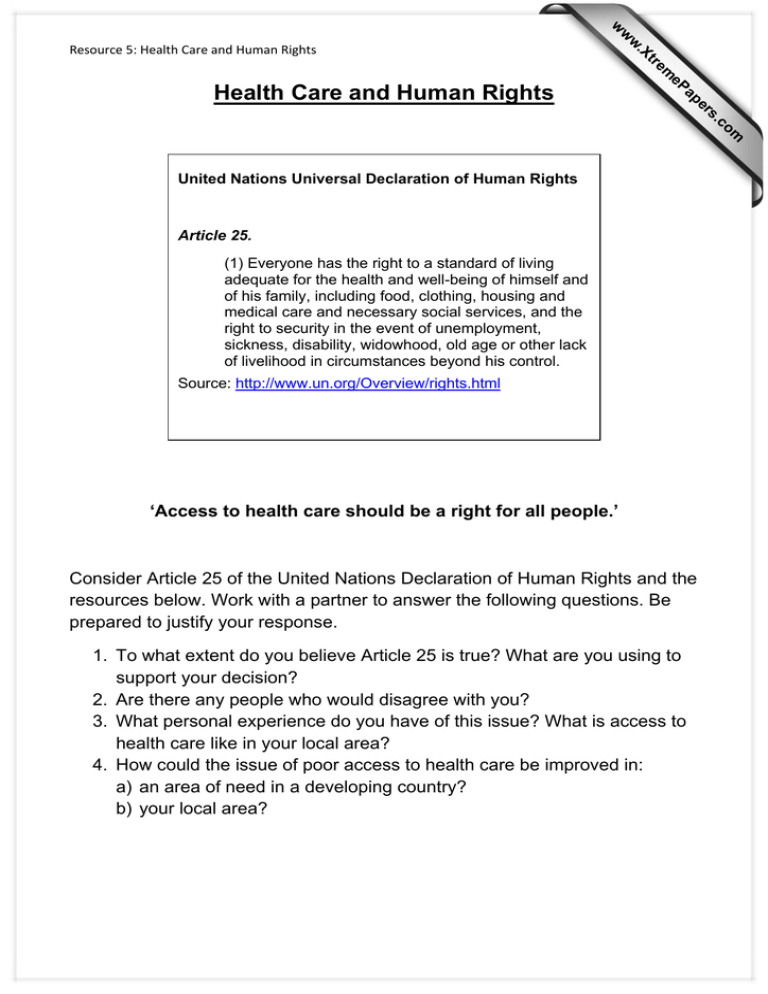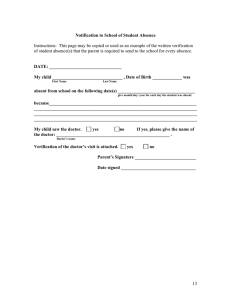Health Care and Human Rights
advertisement

w w Health Care and Human Rights ap eP m e tr .X w Resource 5: Health Care and Human Rights om .c s er United Nations Universal Declaration of Human Rights Article 25. (1) Everyone has the right to a standard of living adequate for the health and well-being of himself and of his family, including food, clothing, housing and medical care and necessary social services, and the right to security in the event of unemployment, sickness, disability, widowhood, old age or other lack of livelihood in circumstances beyond his control. Source: http://www.un.org/Overview/rights.html ‘Access to health care should be a right for all people.’ Consider Article 25 of the United Nations Declaration of Human Rights and the resources below. Work with a partner to answer the following questions. Be prepared to justify your response. 1. To what extent do you believe Article 25 is true? What are you using to support your decision? 2. Are there any people who would disagree with you? 3. What personal experience do you have of this issue? What is access to health care like in your local area? 4. How could the issue of poor access to health care be improved in: a) an area of need in a developing country? b) your local area? Resource 5: Health Care and Human Rights Resource A. An alternative map of health care. Source: http://strangemaps.wordpress.com/2007/10/17/185‐the‐doctorspatients‐map‐of‐the‐world/ Resource B. An extract from HMO Missions http://www.ruf.rice.edu/~hmokenya/orientation.html. This is an agency that helps provide health care in areas of need. Resource 5: Health Care and Human Rights ‘For the people living in the rural areas of Western Kenya, there are major obstacles to access to health care. Although several government run hospitals do exist in the Western Province, they are not adequately equipped to handle the needs of the people. The two major problems are related to the shortage of health care professionals and the access to medications due to both availability and financial restrictions. By establishing a health clinic in Kabula, Kenya, we hope to alleviate some of these problems. From our first hand experiences we have seen unsuccessful development projects that failed due to the donor organizations’ unwillingness to work with the local people. Therefore, to promote sustainable development, we will assist the current infrastructure by working hand in hand with the local health care providers in a mutually beneficial exchange. By working in a nonimposing manner, the clinic will be maintained by the local health care providers even in the absence of members from the donor organization. In the United States, there exist 341 people per doctor, while in the West African nation of Burkina Faso, there are an astounding 57,310 people per doctor. The number of human beings per doctor can serve as a general indicator of access to health care in any given country. Therefore, by examining this figure, one can locate the countries in the world that are the most disadvantaged with respect to access to health care. It deserves mentioning that these figures are averages, meaning that in many rural areas throughout Africa and other developing countries there may be over 100,000 people per doctor.’ Country Region People per Physician Burkino Faso W Africa 57310 Ethiopia E Africa 32500 Cambodia SE Asia 27000 Tanzania E Africa 24970 Nepal NW Asia 16830 Kenya E Africa 10150 Philippines SE Asia 8120 Jamaica C America 6159 India NW Asia 2460 Honduras C America 3090 Bolivia S America 2124 United States N America 341





